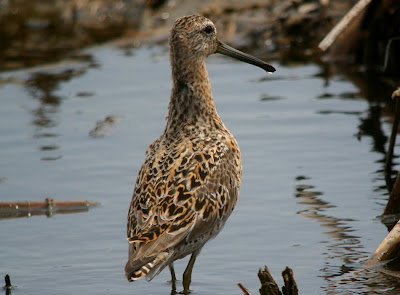The ConceptAs a concept,
digiscoping is as simple as it gets. Put your camera up to a spotting scope's eyepiece and take a picture of what the scope is focused on. However, we often find that in practice things are not as easy as they seem. It's been my experience that one of, if not the biggest challenge of digiscoping, is to get the right mix of scope, camera, and adapter that can easily and effectively be assembled as a complete, photography-ready unit. Why is this?
The ProblemI think the biggest hurdle here is the camera to adapter interface. In today's point-and-shoot camera market there is no uniformity in regards to shape, size, and features. It turns out that camera makers could care less about their products' suitability to digiscoping. As a result, the manufacturers of scopes and digiscoping adapters are forced to come up with intricate, highly adjustable, and often complex universal adapters to fit the plethora of cameras offered to consumers. I'm not interested in making digiscoping any more challenging than it already is. I'll always opt for the route that is fast, simple, and effective.

Pictured above are some of the "universal" digiscoping adapters. Large and mechanically intricate, they offer a less than optimal solution.
The Adapter SolutionThe best hardware for digiscoping is that which requires the least amount of forethought or effort to put into use. In regards to camera adapters, the simple tube-style adapters on the market fit the bill perfectly. These tube adapters are simple, both in design and functionality. The premise is a hollow tube screwed onto the front of your camera lens that can slide over a scope's eyepiece, effortlessly centering both lenses at the proper depth. Not only are these adapters easy to deploy, they are compact and lightweight. Question: what's not to love about this type of setup? Answer: it doesn't work with a lot of cameras.
The Camera SolutionVery few point-and-shoot cameras have the functionality to attach adapters, filters, or boosters to the front lens. The absence of this feature is a design trend that seems to be picking up momentum, and as new models are introduced each year, fewer and fewer of them support filter thread attachments. Here is where a digital single-lens reflex camera (DSLR) fits the bill nicely. Almost all DSLR camera lenses are inherently designed with filter threads that easily adapt to those wonderful tube style adapters. Warning: not all DSLR lenses are suitable for digiscoping. The best lenses are the short focal length lenses. Both Canon and Nikon make 50mm f/1.8 lenses that are relatively inexpensive and perfect for digiscoping. If you're shooting with a Pentax DSLR, you will want the Pentax 40mm f/2.8 “pancake” lens. When using a DSLR for digiscoping, you will need to disable the auto-focus, put the camera on its full manual settings, and set the lens aperture wide open. You will also need to adjust the camera's shutter speed to obtain the proper image exposure.

An exploded view of a full DSLR digiscoping rig, minus a tripod.
Nothing's PerfectUsing a DSLR for digiscoping doesn't come without compromise. DSLR benefits include universal adaptability via a threaded lens and the ability to use, and compose images through, a viewfinder. The drawbacks to DSLR cameras are the inability to use the lens' auto-focus and working with a bigger, heavier camera body. Because of a DSLR's size, I would NOT recommend allowing the camera body and lens to hang unsupported from the spotting scope for any extended period of time.
What Are Your Options?If you've got a DSLR or point-and-shoot camera that uses filter threads, and you need a good digiscoping adapter, I would take a look at the Swarovski DCA, Vortex Razor Digital Adapter, and Kowa DA10 adapter. These three brand-specific adapters accept rings to accommodate various lens thread sizes. I have had some limited luck getting some of these adapters to work with other brands of scopes. For instance, I'm currently digiscoping with the Leica 82mm Televid and, much to my delight, found that the Swarovski DCA adapter fits nicely around the new Leica eyepiece. Be prepared to get creative; if you are going to try to mix and match brands of adapters and scopes, you might need to make your own bushings or modify the adapters in one way or another.
 Pictured above is the current view from my desk at Eagle Optics. On Wednesday we got walloped with 18 inches of heavy snow. The Rio Grande Valley feels very far away as I turn around and look out my window these days.
Pictured above is the current view from my desk at Eagle Optics. On Wednesday we got walloped with 18 inches of heavy snow. The Rio Grande Valley feels very far away as I turn around and look out my window these days. Northern Beardless-Tyrannulet
Northern Beardless-Tyrannulet














 t
t









 For the past few years, I have been fortunate enough to travel to Homer Alaska in early May to attend the
For the past few years, I have been fortunate enough to travel to Homer Alaska in early May to attend the 













 The boardwalk at the convention center allowed excellent close-up looks at rails, waders, and shorebirds, including this Short-billed
The boardwalk at the convention center allowed excellent close-up looks at rails, waders, and shorebirds, including this Short-billed 






